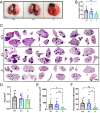AGO2 promotes tumor progression in KRAS-driven mouse models of non-small cell lung cancer
- PMID: 33972443
- PMCID: PMC8157917
- DOI: 10.1073/pnas.2026104118
AGO2 promotes tumor progression in KRAS-driven mouse models of non-small cell lung cancer
Abstract
Lung cancer is the deadliest malignancy in the United States. Non-small cell lung cancer (NSCLC) accounts for 85% of cases and is frequently driven by activating mutations in the gene encoding the KRAS GTPase (e.g., KRASG12D). Our previous work demonstrated that Argonaute 2 (AGO2)-a component of the RNA-induced silencing complex (RISC)-physically interacts with RAS and promotes its downstream signaling. We therefore hypothesized that AGO2 could promote KRASG12D-dependent NSCLC in vivo. To test the hypothesis, we evaluated the impact of Ago2 knockout in the KPC (LSL-KrasG12D/+;p53f/f;Cre) mouse model of NSCLC. In KPC mice, intratracheal delivery of adenoviral Cre drives lung-specific expression of a stop-floxed KRASG12D allele and biallelic ablation of p53 Simultaneous biallelic ablation of floxed Ago2 inhibited KPC lung nodule growth while reducing proliferative index and improving pathological grade. We next applied the KPHetC model, in which the Clara cell-specific CCSP-driven Cre activates KRASG12D and ablates a single p53 allele. In these mice, Ago2 ablation also reduced tumor size and grade. In both models, Ago2 knockout inhibited ERK phosphorylation (pERK) in tumor cells, indicating impaired KRAS signaling. RNA sequencing (RNA-seq) of KPC nodules and nodule-derived organoids demonstrated impaired canonical KRAS signaling with Ago2 ablation. Strikingly, accumulation of pERK in KPC organoids depended on physical interaction of AGO2 and KRAS. Taken together, our data demonstrate a pathogenic role for AGO2 in KRAS-dependent NSCLC. Given the prevalence of this malignancy and current difficulties in therapeutically targeting KRAS signaling, our work may have future translational relevance.
Keywords: AGO2; KRAS; nonsmall cell lung cancer.
Copyright © 2021 the Author(s). Published by PNAS.
Conflict of interest statement
The authors declare no competing interest.
Figures





Similar articles
-
Loss of p53 attenuates the contribution of IL-6 deletion on suppressed tumor progression and extended survival in Kras-driven murine lung cancer.PLoS One. 2013 Nov 15;8(11):e80885. doi: 10.1371/journal.pone.0080885. eCollection 2013. PLoS One. 2013. PMID: 24260500 Free PMC article.
-
MEK1/2 inhibition elicits regression of autochthonous lung tumors induced by KRASG12D or BRAFV600E.Cancer Res. 2012 Jun 15;72(12):3048-59. doi: 10.1158/0008-5472.CAN-11-3649. Epub 2012 Apr 17. Cancer Res. 2012. PMID: 22511580 Free PMC article.
-
An essential role for Argonaute 2 in EGFR-KRAS signaling in pancreatic cancer development.Nat Commun. 2020 Jun 4;11(1):2817. doi: 10.1038/s41467-020-16309-2. Nat Commun. 2020. PMID: 32499547 Free PMC article.
-
Overview of KRAS-Driven Genetically Engineered Mouse Models of Non-Small Cell Lung Cancer.Curr Protoc Pharmacol. 2015 Sep 1;70:14.35.1-14.35.16. doi: 10.1002/0471141755.ph1435s70. Curr Protoc Pharmacol. 2015. PMID: 26331885 Review.
-
Targeting the KRAS variant for treatment of non-small cell lung cancer: potential therapeutic applications.Expert Rev Respir Med. 2016;10(1):53-68. doi: 10.1586/17476348.2016.1115349. Epub 2015 Nov 17. Expert Rev Respir Med. 2016. PMID: 26714748 Review.
Cited by
-
m7G-related gene NUDT4 as a novel biomarker promoting cancer cell proliferation in lung adenocarcinoma.Front Oncol. 2023 Jan 24;12:1055605. doi: 10.3389/fonc.2022.1055605. eCollection 2022. Front Oncol. 2023. PMID: 36761423 Free PMC article.
-
LINC02535/miR-30a-5p/GALNT3 axis contributes to lung adenocarcinoma progression via the NF- κ B signaling pathway.Cell Cycle. 2022 Dec;21(23):2455-2470. doi: 10.1080/15384101.2022.2101336. Epub 2022 Jul 19. Cell Cycle. 2022. PMID: 35852407 Free PMC article.
-
KRAS Hijacks the miRNA Regulatory Pathway in Cancer.Cancer Res. 2023 May 15;83(10):1563-1572. doi: 10.1158/0008-5472.CAN-23-0296. Cancer Res. 2023. PMID: 36946612 Free PMC article.
-
Extracellular Signal-Regulated Kinases: One Pathway, Multiple Fates.Cancers (Basel). 2023 Dec 24;16(1):95. doi: 10.3390/cancers16010095. Cancers (Basel). 2023. PMID: 38201521 Free PMC article. Review.
-
Non-small cell lung cancer organoids: Advances and challenges in current applications.Chin J Cancer Res. 2024 Oct 30;36(5):455-473. doi: 10.21147/j.issn.1000-9604.2024.05.01. Chin J Cancer Res. 2024. PMID: 39539817 Free PMC article.
References
-
- Siegel R. L., Miller K. D., Jemal A., Cancer statistics, 2017. CA Cancer J. Clin. 67, 7–30 (2017). - PubMed
-
- Schubbert S., Shannon K., Bollag G., Hyperactive Ras in developmental disorders and cancer. Nat. Rev. Cancer 7, 295–308 (2007). - PubMed
-
- Trahey M., McCormick F., A cytoplasmic protein stimulates normal N-ras p21 GTPase, but does not affect oncogenic mutants. Science 238, 542–545 (1987). - PubMed
Publication types
MeSH terms
Substances
Grants and funding
LinkOut - more resources
Full Text Sources
Other Literature Sources
Medical
Molecular Biology Databases
Research Materials
Miscellaneous

